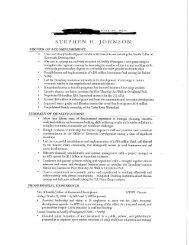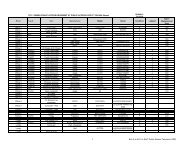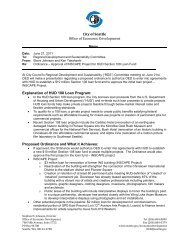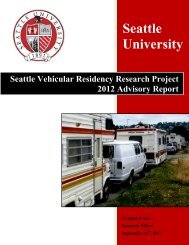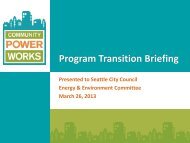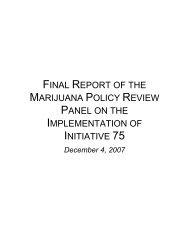2013 Water System Plan, Volume II - Seattle City Clerk's Office - City ...
2013 Water System Plan, Volume II - Seattle City Clerk's Office - City ...
2013 Water System Plan, Volume II - Seattle City Clerk's Office - City ...
Create successful ePaper yourself
Turn your PDF publications into a flip-book with our unique Google optimized e-Paper software.
Household size is calculated for single and multifamily households in <strong>Seattle</strong> and for<br />
wholesale customers over the forecast period based on PSRC projections of single and<br />
multifamily households and population. Since the number of households is expected to<br />
grow faster than population through 2040, household size is projected to decrease over the<br />
next 30 years. The estimates of household size are as follows:<br />
<strong>Seattle</strong><br />
SWP Wholesale Customers<br />
Single Family Mutlifamily Single Family Mutlifamily<br />
2010 2.41 1.93 2.76 2.25<br />
2020 2.32 1.89 2.59 2.19<br />
2030 2.24 1.85 2.50 2.13<br />
2040 2.16 1.81 2.41 2.08<br />
2050 2.16 1.82 2.40 2.09<br />
2060 2.15 1.82 2.40 2.10<br />
A straight-line extrapolation of average annual growth between 2010 and 2040 is used to<br />
forecast population beyond 2040. However, projections of the number of households<br />
beyond 2040 are based on the assumption that household size will stabilize and growth in<br />
the number of households will slow to about the rate of population growth. Per household<br />
flow factors are then reduced each year by the percent change in household size times the<br />
elasticity of demand with respect to household size. This elasticity is estimated to be 0.38<br />
based on data from an end-use study conducted by the <strong>Seattle</strong> <strong>Water</strong> Department in the<br />
mid-1990s.<br />
<br />
Base Year Flow Factors: Base year flow factors are obtained by dividing the weatheradjusted<br />
base year consumption for each sector (e.g. single family residential) and service<br />
area (e.g. Bothell) by the corresponding number of households or employees in the base<br />
year.<br />
<br />
Elasticity of residential demand to changes in real (inflation adjusted) household<br />
income: Household income is generally expected to have a positive effect on water<br />
demand. A review of the literature revealed a range of estimated income elasticities. An<br />
elasticity value of 0.27, representing the middle of this range, was chosen. (This means<br />
that a 10% increase in household income would be expected to cause a 2.7% rise in<br />
residential demand.)<br />
Source: Results of literature review<br />
<br />
Forecast of annual growth in real median household income: Mean household income<br />
was used in the 2007 WSP but on further reflection, median income appears to be the<br />
more appropriate concept. The past 40 years has seen a widening gap between growth in<br />
mean and median income. Both national and local time series on real per capita personal<br />
income show average annual rates of growth of about 2.0%. However after adjusting for<br />
inflation, median household income Washington State and King County is now slightly less<br />
than it was in 1989. The growth rate has been essentially zero. There is additional<br />
evidence that this is not just true for the median household but for most households except<br />
those at the very top of the income distribution. A recent analysis by economists Saez and<br />
Piketty based on 90 years of IRS data reveals that average household income for the<br />
bottom 90% of households has had zero real growth since 1970. Over the same 4<br />
decades, the top 10%, 1%, 0.1%, and 0.01% of households has seen their real incomes<br />
increase twofold, threefold, fivefold and eightfold, respectively. If the present trend<br />
FINAL Page 5 of 22 December 2011



